The Infection Control Market is estimated to be valued at USD 259.1 billion in 2025 and is projected to reach USD 486.4 billion by 2035, registering a compound annual growth rate (CAGR) of 6.5% over the forecast period.
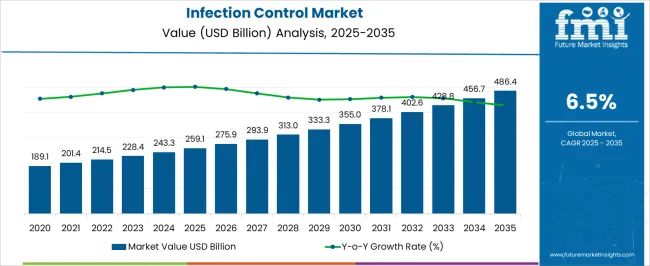
| Metric | Value |
|---|---|
| Infection Control Market Estimated Value in (2025 E) | USD 259.1 billion |
| Infection Control Market Forecast Value in (2035 F) | USD 486.4 billion |
| Forecast CAGR (2025 to 2035) | 6.5% |
The infection control market is experiencing robust growth due to the increasing global emphasis on hygiene, disease prevention, and patient safety across healthcare and community settings. Rising awareness of hospital-acquired infections and outbreaks of contagious diseases are driving the adoption of advanced infection prevention solutions. The market expansion is being supported by growing investments in healthcare infrastructure, sterilization protocols, and hygiene management systems.
Innovative product developments, including disposable and single-use materials, are improving operational efficiency while reducing cross-contamination risks. In parallel, regulatory requirements and international standards for infection control are reinforcing the adoption of certified products and processes.
Hospitals, clinics, and other healthcare facilities are increasingly prioritizing surface disinfection and personal protective measures, contributing to strong demand The convergence of technological advancements, rising patient safety awareness, and government-led infection prevention initiatives is expected to continue propelling market growth over the coming decade, while manufacturers focus on product innovation, scalability, and cost-effective deployment to meet global healthcare needs.
The infection control market is segmented by product, application, end user, and geographic regions. By product, infection control market is divided into Non-Woven Disposable, Sterilization Equipment, and Disinfection Equipment. In terms of application, infection control market is classified into Surface Disinfection and Surgical Disinfection. Based on end user, infection control market is segmented into Hospitals, Diagnostic Laboratories, Academic Institutions, and Clinics. Regionally, the infection control industry is classified into North America, Latin America, Western Europe, Eastern Europe, Balkan & Baltic Countries, Russia & Belarus, Central Asia, East Asia, South Asia & Pacific, and the Middle East & Africa.
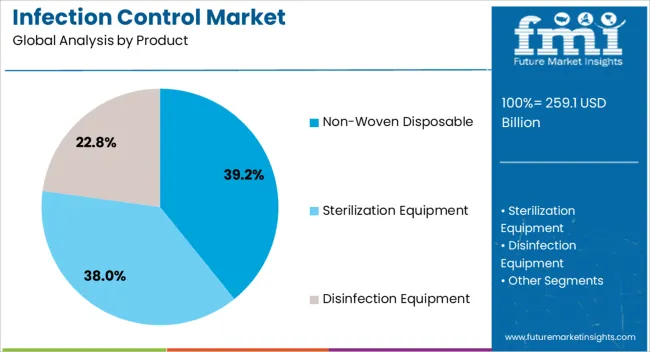
The non-woven disposable product segment is projected to hold 39.2% of the infection control market revenue share in 2025, positioning it as the leading product type. This segment’s dominance is being driven by its ability to provide high hygiene standards, single-use convenience, and reduced contamination risk compared to reusable alternatives. Non-woven materials are lightweight, cost-efficient, and compatible with various sterilization processes, enhancing operational efficiency in hospitals and other healthcare facilities.
Adoption has been reinforced by growing emphasis on single-use protective barriers, including wipes, gowns, and drapes, which help prevent the spread of pathogens. Hospitals and clinical settings favor non-woven disposables for their durability, consistency, and regulatory compliance.
The ability to integrate these products into broader infection prevention protocols without requiring significant infrastructure changes has also fueled their growth As patient safety and hygiene awareness continue to rise globally, non-woven disposable products are expected to maintain leadership within the infection control product landscape.
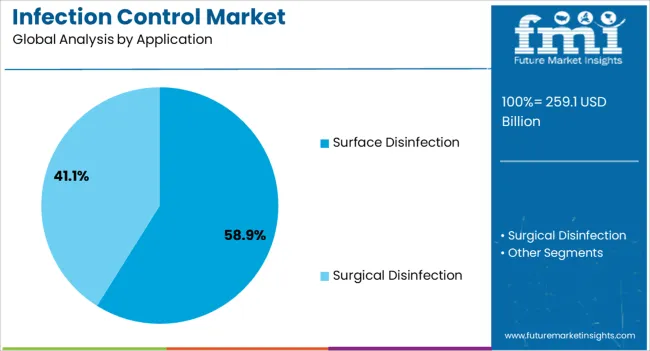
The surface disinfection application segment is anticipated to account for 58.9% of the infection control market revenue share in 2025, establishing it as the leading application area. This leadership is being driven by the critical role surface hygiene plays in preventing hospital-acquired infections and the transmission of infectious diseases.
Growing awareness among healthcare workers and facility managers regarding contamination risks on frequently touched surfaces has reinforced adoption. Surface disinfection solutions, including sprays, wipes, and automated systems, are increasingly being integrated into routine cleaning protocols, improving operational safety and patient outcomes.
Stringent regulatory standards and infection control guidelines issued by international health organizations have further strengthened demand As healthcare facilities aim to reduce infection incidence and improve operational compliance, the surface disinfection segment remains central to infection prevention strategies, with strong adoption expected across hospitals, clinics, and other high-risk environments.
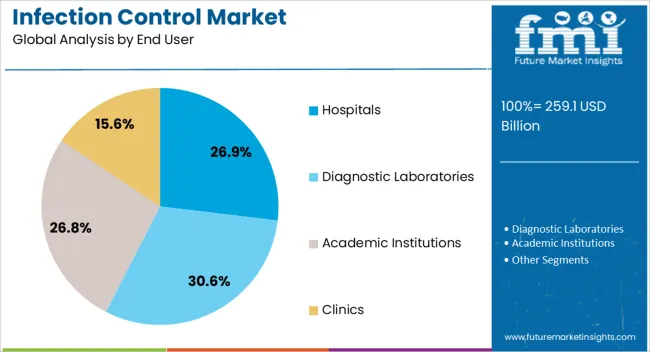
The hospitals end-user segment is projected to hold 26.9% of the infection control market revenue share in 2025, making it the leading end-use industry. This dominance is being driven by the heightened need for infection prevention in high-traffic healthcare settings, where patient safety is a primary concern. Hospitals are adopting comprehensive infection control measures, including non-woven disposable products, surface disinfection systems, and sterilization equipment, to minimize the risk of hospital-acquired infections.
Rising patient admissions, surgical procedures, and healthcare infrastructure expansion are contributing to sustained demand. The segment benefits from regulatory oversight and accreditation requirements that mandate strict infection prevention protocols.
Additionally, hospitals are increasingly integrating infection control products into standard operational workflows, enhancing compliance and overall hygiene As patient safety initiatives and healthcare quality benchmarks intensify globally, hospitals are expected to remain the largest consumer of infection control solutions, driving continued growth in the market.
The major factors such as increasing infection outbreaks, growing number of surgeries, increasing prevalence of chronic disorders associated with the growing old age populace, and the budding medical device reprocessing industry are anticipated to propel the market growth for infection control. Additionally, the growing incidence of hospital-associated infections and surgical site infections is propelling the market growth. Infection control is utilized to reduce the risk of harmful infections, which is highly used in hospitals, clinics, laboratories and research institutes, and food and pharmaceutical manufacturing units. Thus, the increasing demand for infection control in these sectors is boosting the growth of the market.
Moreover, the growth in the outsourcing of sterilization facilities and the introduction of innovative sterilizing solutions are expected to contribute to the growth of the infection control market. Furthermore, to ensure a high degree of infection prevention, the government is taking a number of initiatives, which is attributed to show significant growth in the infection control market.
North America holds a larger market share in the infection control market followed by Europe, East Asia, South Asia, and other regions. The lucrative growth in North America is attributed due to the increasing adoption of disinfection and sterilization equipment, and rising concerns about disease prevention among the population.
The Asian regions are expected to be the rapidly growing regions owing to the COVID-19 outbreak, increasing focus of government on the healthcare sector, and growing prevalence of chronic illness. Latin America and the Middle East and Africa are estimated to show sustainable growth during the projected period.
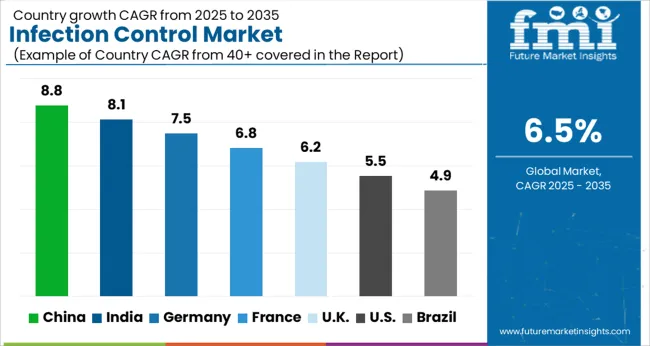
| Country | CAGR |
|---|---|
| China | 8.8% |
| India | 8.1% |
| Germany | 7.5% |
| France | 6.8% |
| UK | 6.2% |
| USA | 5.5% |
| Brazil | 4.9% |
The Infection Control Market is expected to register a CAGR of 6.5% during the forecast period, exhibiting varied country level momentum. China leads with the highest CAGR of 8.8%, followed by India at 8.1%. Developed markets such as Germany, France, and the UK continue to expand steadily, while the USA is likely to grow at consistent rates. Brazil posts the lowest CAGR at 4.9%, yet still underscores a broadly positive trajectory for the global Infection Control Market. In 2024, Germany held a dominant revenue in the Western Europe market and is expected to grow with a CAGR of 7.5%. The USA Infection Control Market is estimated to be valued at USD 95.1 billion in 2025 and is anticipated to reach a valuation of USD 162.8 billion by 2035. Sales are projected to rise at a CAGR of 5.5% over the forecast period between 2025 and 2035. While Japan and South Korea markets are estimated to be valued at USD 12.8 billion and USD 8.2 billion respectively in 2025.
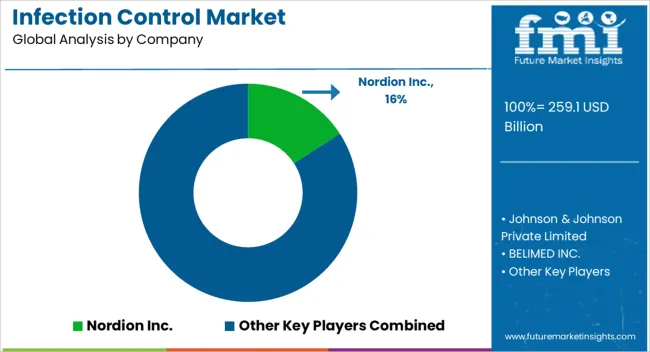
| Item | Value |
|---|---|
| Quantitative Units | USD 259.1 Billion |
| Product | Non-Woven Disposable, Sterilization Equipment, and Disinfection Equipment |
| Application | Surface Disinfection and Surgical Disinfection |
| End User | Hospitals, Diagnostic Laboratories, Academic Institutions, and Clinics |
| Regions Covered | North America, Europe, Asia-Pacific, Latin America, Middle East & Africa |
| Country Covered | United States, Canada, Germany, France, United Kingdom, China, Japan, India, Brazil, South Africa |
| Key Companies Profiled | Nordion Inc., Johnson & Johnson Private Limited, BELIMED INC., Getinge AB., Medivators Inc., Kimberly-Clark Corporation, CISA Group, STERIS, Ecolab, and Advanced Sterilization Products |
The global infection control market is estimated to be valued at USD 259.1 billion in 2025.
The market size for the infection control market is projected to reach USD 486.4 billion by 2035.
The infection control market is expected to grow at a 6.5% CAGR between 2025 and 2035.
The key product types in infection control market are non-woven disposable, _drapes, _gowns, _sterilization wraps, _face mask, sterilization equipment, _heat sterilization equipment, _moist heat sterilization equipment, _dry heat sterilization equipment, _low-temperature sterilization equipment, _radiation sterilization equipment, disinfection equipment, _disinfector, _washer disinfector, _flusher disinfector, _endoscopic reprocessor systems, _high-end endoscopic reprocessor systems, _mid-range endoscopic reprocessor systems, _low-end endoscopic reprocessor systems and _disinfectants.
In terms of application, surface disinfection segment to command 58.9% share in the infection control market in 2025.






Our Research Products

The "Full Research Suite" delivers actionable market intel, deep dives on markets or technologies, so clients act faster, cut risk, and unlock growth.

The Leaderboard benchmarks and ranks top vendors, classifying them as Established Leaders, Leading Challengers, or Disruptors & Challengers.

Locates where complements amplify value and substitutes erode it, forecasting net impact by horizon

We deliver granular, decision-grade intel: market sizing, 5-year forecasts, pricing, adoption, usage, revenue, and operational KPIs—plus competitor tracking, regulation, and value chains—across 60 countries broadly.

Spot the shifts before they hit your P&L. We track inflection points, adoption curves, pricing moves, and ecosystem plays to show where demand is heading, why it is changing, and what to do next across high-growth markets and disruptive tech

Real-time reads of user behavior. We track shifting priorities, perceptions of today’s and next-gen services, and provider experience, then pace how fast tech moves from trial to adoption, blending buyer, consumer, and channel inputs with social signals (#WhySwitch, #UX).

Partner with our analyst team to build a custom report designed around your business priorities. From analysing market trends to assessing competitors or crafting bespoke datasets, we tailor insights to your needs.
Supplier Intelligence
Discovery & Profiling
Capacity & Footprint
Performance & Risk
Compliance & Governance
Commercial Readiness
Who Supplies Whom
Scorecards & Shortlists
Playbooks & Docs
Category Intelligence
Definition & Scope
Demand & Use Cases
Cost Drivers
Market Structure
Supply Chain Map
Trade & Policy
Operating Norms
Deliverables
Buyer Intelligence
Account Basics
Spend & Scope
Procurement Model
Vendor Requirements
Terms & Policies
Entry Strategy
Pain Points & Triggers
Outputs
Pricing Analysis
Benchmarks
Trends
Should-Cost
Indexation
Landed Cost
Commercial Terms
Deliverables
Brand Analysis
Positioning & Value Prop
Share & Presence
Customer Evidence
Go-to-Market
Digital & Reputation
Compliance & Trust
KPIs & Gaps
Outputs
Full Research Suite comprises of:
Market outlook & trends analysis
Interviews & case studies
Strategic recommendations
Vendor profiles & capabilities analysis
5-year forecasts
8 regions and 60+ country-level data splits
Market segment data splits
12 months of continuous data updates
DELIVERED AS:
PDF EXCEL ONLINE
Point Of Care Infection Control Market
Hospital-Acquired Infection (HAI) Control Market – Prevention & Growth Trends 2025 to 2035
Infection Prevention Market is segmented by Product type and End User from 2025 to 2035
Disinfection Cap Market Size and Share Forecast Outlook 2025 to 2035
Disinfection Equipment Market Analysis - Trends & Forecast 2025 to 2035
Global Eye Infections Treatment Market Report - Trends & Forecast 2025 to 2035
Yeast Infection Diagnostics Market Report - Demand, Trends & Industry Forecast 2025 to 2035
Yeast Infection Treatment Market by Drug Type, Distribution Channel, End User, and Region, 2025 to 2035
UVC Disinfection Product Market Report – Demand, Trends & Forecast 2025–2035
Systemic Infection Treatment Market
Difficile Infections (Clostridium Difficile Associated Disease) Market Size and Share Forecast Outlook 2025 to 2035
Pertussis Infection Testing Market
Norovirus Infection Treatment Market
Self-urinary Infection Testing Market Size and Share Forecast Outlook 2025 to 2035
Urinary Tract Infection (UTI) Treatment Market (UTI) Analysis - Size, Share, and Forecast 2025 to 2035
Urinary Tract Infection Testing Market Analysis – Size, Share, & Forecast Outlook 2025 to 2035
Pork Tapeworm Infection Treatment Market Trends – Demand & Innovations 2025 to 2035
Surgical Site Infections Market
Toxoplasmosis Infection Treatment Market
UVC Surface Disinfection System Market Size and Share Forecast Outlook 2025 to 2035

Thank you!
You will receive an email from our Business Development Manager. Please be sure to check your SPAM/JUNK folder too.
Chat With
MaRIA